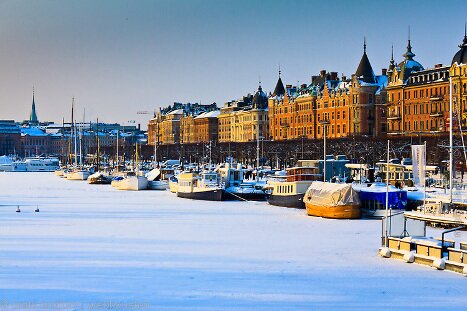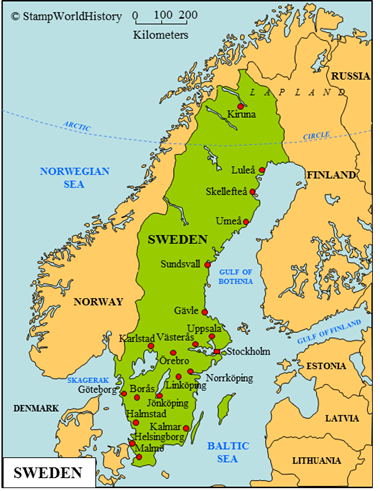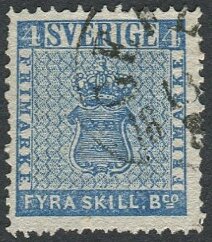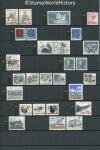
Sweden
Union with Norway

Sweden
Kingdom
Quick reference
General issues: Kingdom in personal union with Norway 1855-1905, Kingdom 1905-Present
Country name on general issues: Sverige
Special issues: Local issues Stockholm 1856-1862
Currency: 1 Riksdaler = 48 Skilling Banco 1855-1858, 1 Riksdaler = 100 Öre 1858-1875, 1 Krona = 100 Öre 1875-Present
Population: 5 136 000 in 1900, 9 880 000 in 2016
Political history Sweden
A major European power in the 16th and 17th centuries
Sweden is located in northern Europe. Sweden emerged as a unified kingdom in the 11th and 12th centuries in southern Sweden and expanded north and into present day Finland. By way of the Treaty of Kalmar, Sweden and Norway, in 1397, came to be ruled in personal union by the king of Denmark. Sweden broke away from the union in 1523. In the 16th and 17th centuries, Sweden developed to become one of the major powers in Europe, expanding into the Baltic and Germany and reaching it largest extent in 1658. By the end of the 17th century, Sweden’s power waned and in the early 18th century Sweden had to cede its possessions in the Baltic and most of its possessions in Germany.
Shaping modern Sweden in the 19th and early 20th centuries
The complex dynamics of the Napoleonic Wars in the early 19th century resulted in Sweden ceding Finland to Russia in 1809. In 1814, by way of the Treaty of Kiel, Sweden also ceded its remaining possessions in Germany. At the same time though, the personal union between Denmark and Norway was dissolved and Norway came to be ruled in personal union by Sweden. The Norwegians opposed Swedish rule but, after a short war in 1814, Norwegian opposition was suppressed, although Norway was allowed to retain its own constitution and institutions. In the course of the 19th century, the call for independence grew louder in Norway, and, in 1905, the personal union with Sweden was peacefully dissolved. Thus, the borders of Sweden were defined as we know them today.
Neutrality
The last war in which Sweden was engaged was the 1814 war with Norway. Since then Sweden has pursued a policy of neutrality. Thus, Sweden has stayed out of WWI and WWII, although Sweden made certain concessions to the much more powerful Germany in both wars. At the same time, in WWII, Sweden served as a sanctuary for many refugees from occupied Europe. Sweden, formally, continued its policy of neutrality during the Cold War, although, informally, Sweden aligned with western countries. After the Cold War, in 1995, Sweden joined the European union.
Politics

Stockholm is the capital of Sweden
Sweden became a constitutional monarchy in 1866 and has been a stable parliamentary democracy since then. In the 20th century, Swedish politics have long been dominated by the social democratic side of the political spectrum. Sweden developed into a welfare state after the Scandinavian model, in which the government plays an important part in sectors such as education, health care and social security.
Economy
Economically, Sweden was an agricultural country until well into the 19th century. Industrialization developed in the late 19th and early 20th centuries. Sweden’s economy boomed in the post WWII period when Sweden, with its industry intact, provided many goods to Europe as Europe was recovering from the devastation of the war. Modern Sweden is a mixed free market economy with a strong manufacturing sector. Services provide the largest part of the GDP. Sweden is a wealthy country, ranking 14th on the United Nations Index for Human development. Although Sweden is part of the European Union, it has retained its own currency.
Demographics
The population consists of 80% native Swedes and about 20% foreign born immigrants from both Europe and outside Europe – many of the latter being refugees from conflict zones such as the former Yugoslavia, the Middle East, Somalia and Afghanistan.[1]The exact percentages vary depending on the resources used. Quoted is Statistics Sweden. Most of the population is concentrated in the south of the country. Sweden is an urbanized country with 85% of the population living in urban areas. A small population of Sami, living in the northern region of Lapland, is recognized as an indigenous people.[2]The Sami are a semi nomadic people also found in Norway, Finland and Russia. The Sami are, traditionally, also known as Lapps or Laplanders.
Postal history Sweden
The first stamps were issued in Sweden in 1855, showing the coat of arms. A color error of the 3 skilling denomination – yellow instead of blue-green – is the world’s second most expensive stamp, and is known as the ‘Treskilling Yellow’.[3]The world’s most expensive stamp is the British Guinana ‘Black on Magenta’. Apparently, while printing the yellow 8 skilling denomination, a stereotype[4]A stereotype is a part of a printing plate. was damaged and replaced by a 3 skilling stereotype. Thus, a number of stamps of the 3 skilling denomination was printed in yellow. The only specimen known to date was found in 1886. Stamps for local mail were issued in Stockholm in 1856 and 1862. In 1885, the Swedish King Oskar II first appeared on a stamp. The Swedish monarchs are featured on definitives until today. The first commemorative was issued in 1903 at the occasion of the opening of the new central post office in Stockholm. Throughout its stamp issuing history, Sweden has had a moderate stamp production with themes, mainly, of national interest.
Album pages
← Previous page: NorwayNext page: Switzerland →












